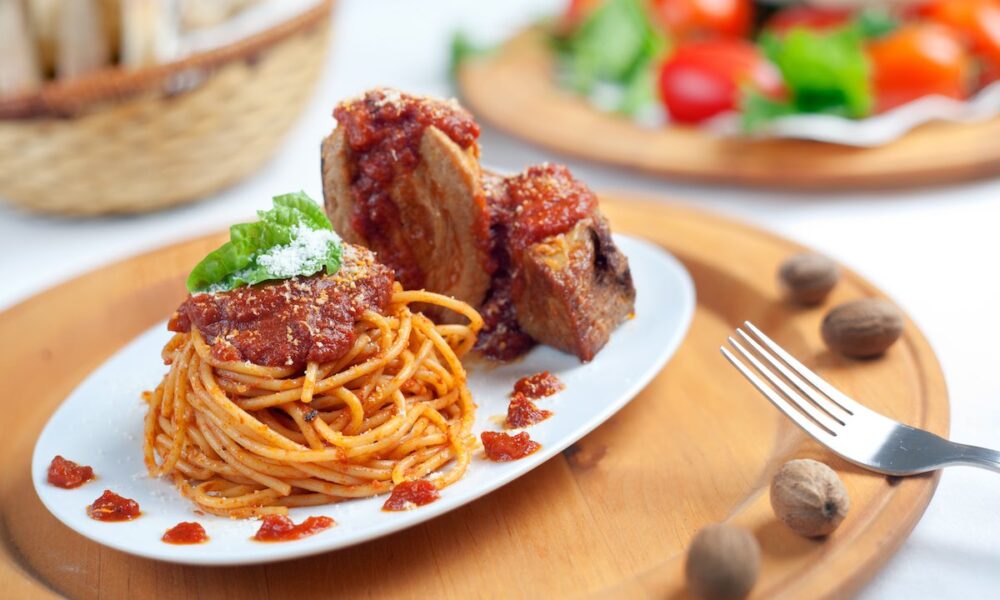Recipes
Neapolitan ragù: the original recipe (for those in no hurry)

How is Neapolitan ragù made? Here are the ingredients and the typical Neapolitan recipe perfect for seasoning succulent pasta dishes.
Neapolitan ragù, also known as 'o rraù in dialect, is a typical condiment of Neapolitan cuisine. For Neapolitans, ragù is an institution and like any typical recipe there are different variations: there are those who use only beef and those who opt for a mixture of pork and beef. Generally the sauce is used to season pasta, while the meat is consumed as a second course together with broccoli.
An unmistakable characteristic of this recipe is the rather long preparation : DOC Neapolitans start preparing the ragù the evening before the day it is to be consumed, because the sauce must "pippiare" (simmer) for at least 6 hours . Here is the original recipe step by step!
How to prepare the Neapolitan ragù recipe
- Start by seasoning the chops : they are thin slices of meat that we will season with salt , pepper , chopped garlic , parmesan and parsley .
- Roll up the chops and secure them with toothpicks or tie them with kitchen twine.
- Cut the blancmange into rather large pieces. Leave sausages and ribs whole.
- In a pan (traditionally copper) brown all the meat in a little oil. When it is sealed on all sides, temporarily transfer it to a plate and brown the finely sliced onion in the same oil.
- Put the meat back in the pan, add the wine and add the tomato sauce , seasoning with salt. The Neapolitan ragù should cook for at least 2 hours by placing the cucchiarella (the wooden spoon) on the pan so that it keeps the lid slightly lifted. In jargon we say that it must pippiare , that is, simmer gently.
- Once ready, use the sauce to season the pasta and serve the meat as a second course.
Preparing Neapolitan ragù is not at all difficult but if you want to do it following tradition the undertaking could prove more difficult, thanks to the long cooking and the recipe not being well codified . In fact, we have offered you our family's version but as Neapolitans know, everyone has their own recipe which, obviously, is the best.
We also leave you a short video where you can see all the steps to bring this sumptuous Sunday dish to the table. Do you recognize the poem in the background? We'll reveal the story to you shortly!
Neapolitan ragù: between history and legend
The Neapolitan ragù has as its ancestor a typical dish of Provençal cuisine , the daube de boeuf , a meat and vegetable stew, in turn inspired by the ragout , always based on meat (in this case mutton) and vegetables. The term derives from the ancient French ragoutant which means tempting, appetizing.
The recipe spread to Naples thanks to Ferdinand IV of Bourbon or rather, thanks to his wife Carolina of Habsburg Lorraine. At the end of the 18th century, in fact, the fashion of having French chefs at court was becoming increasingly widespread. They brought their recipes but the names were brutally distorted. This is how the ragout becomes ragù, the gateau the gatò and the surtat the sartù.
The first written trace is contained in Il cuoco galante by Vincenzo Corrado where the recipe appears for the first time in its current form, i.e. with tomato. However, some maintain that a similar dish was present in the city as early as 1300.
Today Neapolitan ragù is a real institution. Just think that it was once prepared by the groom's mother and brought as a gift to the future wife together with the recipe. This was a sign of acceptance in the family, unfortunately the recipe often lacked some ingredient or step so as to "force" the son to always return home.
Over the years, the recipe has also been praised in some compositions such as Eduardo De Filippo's poem 'O rraù :
« 'O rraù ca me I like it
He told me about his mother.
Why am I sorry to you,
we talked about it and he talked about it.
I'm not difficult to use;
but luvàmmel' 'to my use this customYes, it's good: as you want.
How did we have any stickiness?
What do you say? What is rraù?
And I'll let you eat me…
Can you make me say a word?…
This is meat in pummarola »
But that's not all. A legend tells that at the end of the 14th century the White Company went around the city invoking "mercy and peace" and inviting people to forgive their enemies. They were welcomed positively, except for one nobleman, spiteful and enemy of all . He didn't give in even when his infant son miraculously pronounced the Company's motto three times.
The man was blinded by anger so his wife, in an attempt to tame him, prepared him a plate of macaroni which however turned into blood. Struck by the miracle, the man calmed down and accepted the invitation to peace. Prepared a second time, the macaroni dish was seasoned with a delicious red sauce that the man named after his son, i.e. raù .
Bolognese ragù derives from Neapolitan ragù , the meat classic that has made Italy famous throughout the world for its cuisine.
Conservation
The Neapolitan ragù can be kept in the refrigerator, well covered in cling film, for 2-3 days.
Riproduzione riservata © - WT